英语教学设计大赛
教学设计大赛总结英语初中
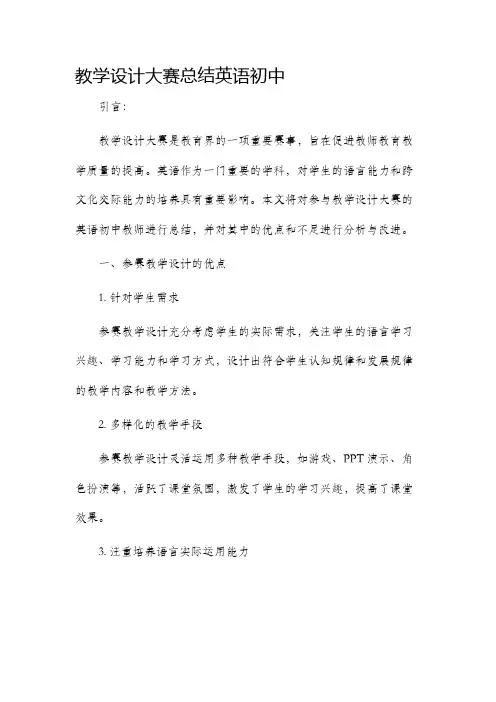
教学设计大赛总结英语初中引言:教学设计大赛是教育界的一项重要赛事,旨在促进教师教育教学质量的提高。
英语作为一门重要的学科,对学生的语言能力和跨文化交际能力的培养具有重要影响。
本文将对参与教学设计大赛的英语初中教师进行总结,并对其中的优点和不足进行分析与改进。
一、参赛教学设计的优点1. 针对学生需求参赛教学设计充分考虑学生的实际需求,关注学生的语言学习兴趣、学习能力和学习方式,设计出符合学生认知规律和发展规律的教学内容和教学方法。
2. 多样化的教学手段参赛教学设计灵活运用多种教学手段,如游戏、PPT演示、角色扮演等,活跃了课堂氛围,激发了学生的学习兴趣,提高了课堂效果。
3. 注重培养语言实际运用能力参赛教学设计注重培养学生的英语实际运用能力,通过语言输入和输出的环节,让学生在课堂中主动运用所学知识,提高语言表达和交际能力。
二、参赛教学设计的不足之处1. 缺乏个性化教学部分参赛教学设计忽视了学生的个体差异,过于依赖课本内容和标准答案,没有充分考虑学生的差异化需求,导致课堂上学生的参与度不高,教学效果不佳。
2. 缺乏评估和反馈机制部分参赛教学设计没有充分考虑学生学习反馈和教学评估的机制,无法及时了解学生的学习情况和进步,对教学效果的评估也较为粗略,难以指导教师的进一步改进。
3. 缺乏思辨性训练部分参赛教学设计注重语法和词汇的教学,忽略了思辨和批判性思维的训练,导致学生的语言能力虽然提高了,但是在解决实际问题时的运用能力相对较弱。
三、改进措施和建议1. 制定个性化学习计划鼓励教师根据学生的个体差异制定个性化的学习计划,充分考虑学生的兴趣、能力和学习方式,为每位学生提供更加贴近他们需求的教学内容和教学方法。
2. 加强评估与反馈建立有效的课堂评估和学生反馈机制,通过测验、作业和口头反馈等方式,及时了解学生的学习情况和进步,并提供个性化的指导和帮助,以便教师能够对教学进行及时调整和改进。
3. 引入思维训练和实践活动注重培养学生的思辨能力和批判性思维能力,设计能够激发学生思考和实践能力的教学活动,如讨论、小组合作、仿真实践等,提高学生在实际问题解决中的语言运用能力。
英语专业优秀教学设计一等奖5篇
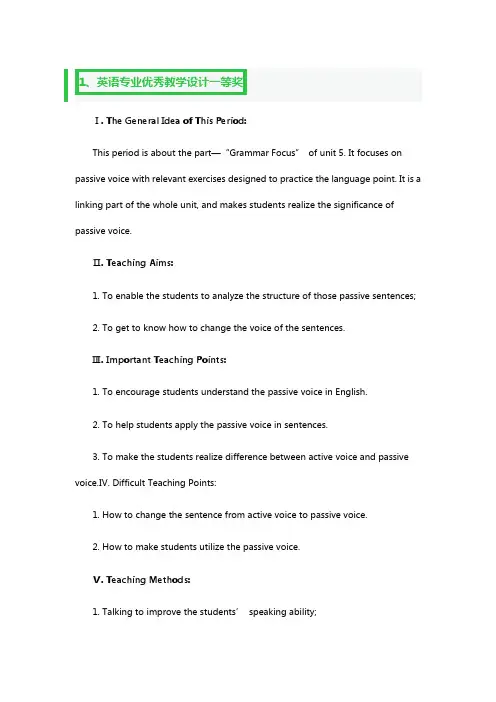
1、英语专业优秀教学设计一等奖Ⅰ. The General Idea of This Period:This period is about the part—“Grammar Focus”of unit 5. It focuses on passive voice with relevant exercises designed to practice the language point. It is a linking part of the whole unit, and makes students realize the significance of passive voice.Ⅱ. Teaching Aims:1. To enable the students to analyze the structure of those passive sentences;2. To get to know how to change the voice of the sentences.Ⅲ. Important Teaching Points:1. To encourage students understand the passive voice in English.2. To help students apply the passive voice in sentences.3. To make the students realize difference between active voice and passive voice.Ⅳ. Difficult Teaching Points:1. How to change the sentence from active voice to passive voice.2. How to make students utilize the passive voice.Ⅴ. Teaching Methods:1. Talking to improve the students’speaking ability;2. Situational dialogue to arouse the interest of students;3. Discussion to make every student work in class.Ⅵ. Teaching Aids:1. The multimedia2. The blackboardⅦ. Teaching Procedures:Step1 Lead-in1. Greet the whole class as usual.T: Class begins! Good morning everyone! Sit down, please! Today, we will come to learn Unit5, grammar focus, passive voice. Take it easy! Firstly, we will watcha short film from the “Freaky Friday”.2. Review a short video from the film (Freaky Friday) we have watched.(1) Ask Students to act the film.(2) The others talk about what they are doing.T: can you remember the last four sentences of the video? (Play the slides) And try to imitate these sentences with me, OK? (Practice for 3 times) Now, try to role play in pair. OK, go!3. Review the passive sentences we have learned in this unit.(1) Read the passive sentences on the screen.(2) Try to find out the model of the passive sentences.Step 2 Grammar learning1. Structure of passive sentencesT: As we all know, sentences can be divided into passive voice sentences and active voice sentences. What is the similarity of these sentences?Active voice(On the blackboard) VoicePassive voiceT: As we can see, the structure is like “be + v-pp”(write on the blackboard). T: We have just mentioned, “我乘坐机车是不被允许的`”how to say?T: Then,”抽烟是不被允许的”how to say?(play the slide)T: Let’s see some past participant of some usual verbs. There are three types changes of v-pp. (play the slides)T: The jacket _____ (make) wool. (Play the slides).A bank _____ (rob) yesterday. (Play the slides).The rice _____ (grow) in China. (Play the slides).T: OK, turn to page 36, group4 and group5 read the questions, and group 1/2/3read the answers. Clear? Are you…ready go!2. Voice exchange(1) Simple sentence “刘谦变魔术”how to say?(Play the slide) Then, how tochange it into passive voice?(2) 4 steps of change the voice of a sentence. (Play the slides)(3) Many people speak English all over the world. (Demonstrate the 4 steps onthe blackboard)Step 3 practiceT: Until now, we have learned the way of change the voice of a sentence. Do you know how to do it?T: According to the four steps, we can rewrite following sentences. And try to finish 4b in groups, OK?T: OK, let’s check the answer.T: Let’s do some exercises to apply the passive voice in sentences. (Show them some photos of their everyday activities and give them some help in necessary.) Try to describe the picture by two voices; you can do it in pairs. OK, go!T: Who would like to share your answer with us? (Point 4-5 pairs)Step 4 Homework1. Finish the Section A of the Exercise book;2. Prepare for the dictation.2、英语专业优秀教学设计一等奖一、教学内容:Lesson 6 Fruits二、教学目标:1、能听懂会说单词:orange , apple , peach , watermelon , pear , grapes , banana .2、能听懂句子进行会话:3、通过创设情境,使学生感受并运用语言,进一步培养学生口语交际能力。
英语教学设计大赛优秀教案
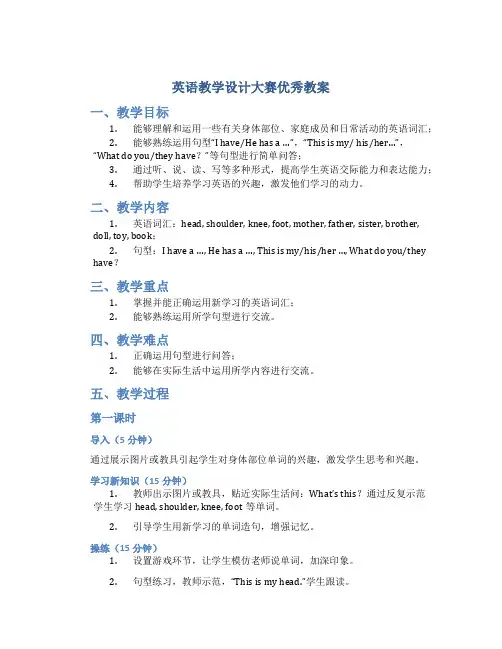
英语教学设计大赛优秀教案一、教学目标1.能够理解和运用一些有关身体部位、家庭成员和日常活动的英语词汇;2.能够熟练运用句型“I have/He has a …”,“This is my/ his/her…”,“What do you/they have?”等句型进行简单问答;3.通过听、说、读、写等多种形式,提高学生英语交际能力和表达能力;4.帮助学生培养学习英语的兴趣,激发他们学习的动力。
二、教学内容1.英语词汇:head, shoulder, knee, foot, mother, father, sister, brother, doll, toy, book;2.句型:I have a …, He has a …, This is my/his/her …, What do you/they have?三、教学重点1.掌握并能正确运用新学习的英语词汇;2.能够熟练运用所学句型进行交流。
四、教学难点1.正确运用句型进行问答;2.能够在实际生活中运用所学内容进行交流。
五、教学过程第一课时导入(5分钟)通过展示图片或教具引起学生对身体部位单词的兴趣,激发学生思考和兴趣。
学习新知识(15分钟)1.教师出示图片或教具,贴近实际生活问:What’s this?通过反复示范学生学习head, shoulder, knee, foot等单词。
2.引导学生用新学习的单词造句,增强记忆。
操练(15分钟)1.设置游戏环节,让学生模仿老师说单词,加深印象。
2.句型练习,教师示范,“This is my head.”学生跟读。
输出(10分钟)让学生表演小故事,使用所学单词和句型,培养学生表达能力。
第二课时导入(5分钟)复习上节课所学内容,让学生回忆单词和句型。
学习新知识(15分钟)1.引入家庭成员单词mother, father, sister, brother,通过图片或教具教学。
2.学习句型“我有…”,“他/她有…”,“这是我的…”,“你们有什么?”并进行示范。
初中英语的优秀教学设计一等奖3篇
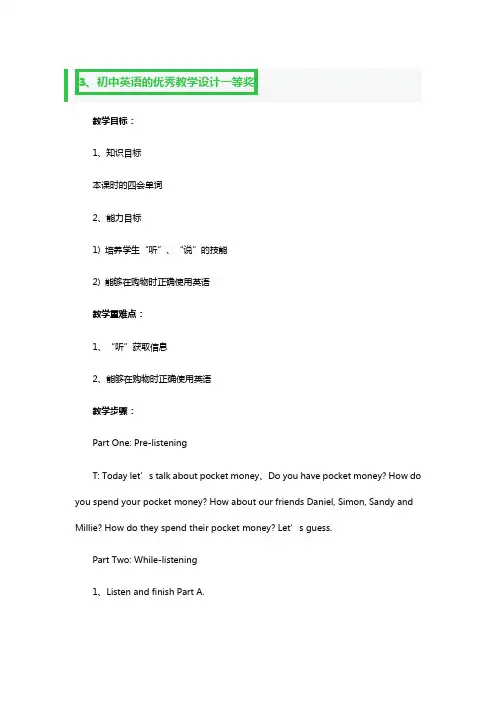
3、初中英语的优秀教学设计一等奖教学目标:1、知识目标本课时的四会单词2、能力目标1) 培养学生“听”、“说”的技能2) 能够在购物时正确使用英语教学重难点:1、“听”获取信息2、能够在购物时正确使用英语教学步骤:Part One: Pre-listeningT: Today let’s talk about pocket money、Do you have pocket money? How do you spend your pocket money? How about our friends Daniel, Simon, Sandy and Millie? How do they spend their pocket money? Let’s guess.Part Two: While-listening1、Listen and finish Part A.T: Please listen to the tape and finish Part A on page 84、Let’s check the answers.2、Listen and fill in the blanks.T: After listening, please fill in the blanks.3、Listen and write.T: Simon often spends money on football cards、What else does he like to buy?Ss: CDs, sports shoes, stationery and T-shirts.T: How often does he buy CDs?Ss: Sometimes.T: How often does he buy sports shoes, stationery and T-shirts? Please listen and answer.Ss: …Do poor children spend pocket money like Simon?Ss: No.T: Please look at the table on page 84、How often do poor children buy CDs?Ss: Never.T: How often do they buy sports shoes, stationery and T-shirts? Please listen again and write down the answers.Ss:…Part Three: Post-listeningT: Please read the advertisement on page 84 and complete the letter on page 85、Let’s read this letter together.Part Four: Speak up1、Listen and answer.T: We know Simon always spends his pocket money on football boots、Today he wants to buy a new pair、How much are the football boots? Please listen and think about this question.Ss: …2、Read and answer.T: Please read after the tape and think about these questions.Ss: …1、Read it in groups.2、Do an activity.T: Suppose you’d like to buy other things、Please work in groups of three and talk about the things in Part C2 on page 85、Use the dialogue in Part C1 as a model.家庭作业:1 Read the dialogue on page 85.2 Complete the following dialogue according to the Chinese sentences.王兰打算买一条尺寸为24号的牛仔裤,可试穿后发现有点小。
全国小学英语优质课竞赛一等奖教案
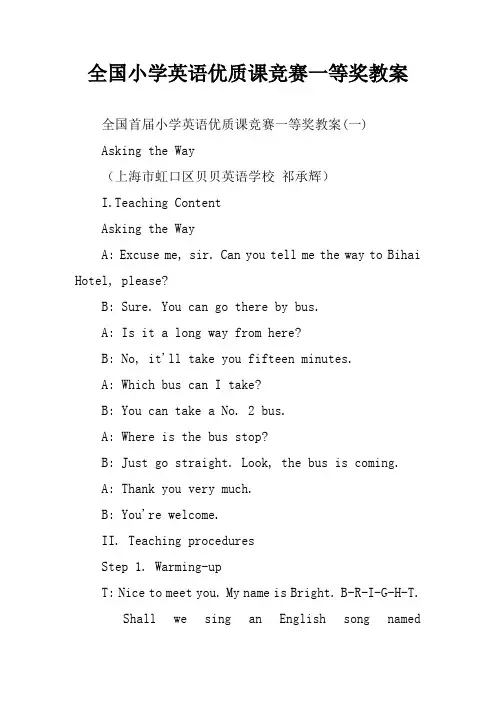
全国小学英语优质课竞赛一等奖教案全国首届小学英语优质课竞赛一等奖教案(一)Asking the Way(上海市虹口区贝贝英语学校祁承辉)I.Teaching ContentAsking the WayA: Excuse me, sir. Can you tell me the way to Bihai Hotel, please?B: Sure. You can go there by bus.A: Is it a long way from here?B: No, it'll take you fifteen minutes.A: Which bus can I take?B: You can take a No. 2 bus.A: Where is the bus stop?B: Just go straight. Look, the bus is coming.A: Thank you very much.B: You're welcome.II. Teaching proceduresStep 1. Warming-upT: Nice to meet you. My name is Bright. B-R-I-G-H-T.Shall we sing an English song named"Bingo", and try to change the' word "Bingo" with my name "Bright"?Step 2. PresentationT: I'm new here, when I arrived at the airport, I heard someone said "对不起"(注①),"早晨好"(注②).I really want to know their meanings in English. Could you help me?S: "对不起" is "Excuse me" and "早晨好" is "Good morning".T: Thanks a lot. And now could you tell me something about your city? I want to travel in this city, but I don't know where I should go.S1: Bai Lian Dong Park.S2: Fisher Girl.S3: Jiuzhou Town.T: Good. But I want to find a hotel now.Please do me a favour. Can you tell me the names of some hotels in this city?S1: XX Hotel.S2: Yindu Hotel.S3: Bihai Hotel.(The teacher takes notes while the students arespeaking.)Step 3. New structures learningT: They all sound very nice. But how can I get there, by bus or by bike?S: By bus.T: And how long will it take me to get there? Maybe fifteen minutes is enough.(The teacher looks at the watch and gives the students a gesture.)1) Draw a stick-figure picture to help the students understand the meaning ofthe sentence:"It'll take someone some time to do something."2) Write the sentence "It'll take you fifteen minutes. " on the blackboard, andhave the students imitate the sentence.3) A guessing game:T: Please look at these pictures and guess "How long will it take me to ...?"T: How long will it take me to have a football match?S1: It'll take you ninety minutes.T: Yes.4) Get the students to listen to the recording of the dialogue, in order tointroduce the new sentence: "Just go straight."5) Use the multi-media to help the students understand the meaning of thesentence "Go straight."6) Write the sentence on the blackboard, and have the students imitate thesentence: "Just go straight."Step 4. Practice1) Ask the students to listen to the dialogue once more, then ask them to repeatafter the tape, first individually and then in pairs.2) Encourage the students to read their dialogue with their deskmates.Step 5. ConsolidationT: You know I'm from Shanghai. Maybe in the future you'll go to Shanghai, soI've prepared some photographs for you.1) Show the photographs of "Nanjing Road", "udong New Area" and "the Bund" to the students.2) Get the students to ask the teachers from Shanghai something they don'tknow, such as directions, transportations in Shanghai.3) Ask some students to introduce their tour plans to Shanghai.注①、注②:因竞赛在珠海举行,授课教师用广东话说“对不起”和“早晨好”。
英语教学设计大赛优秀教案
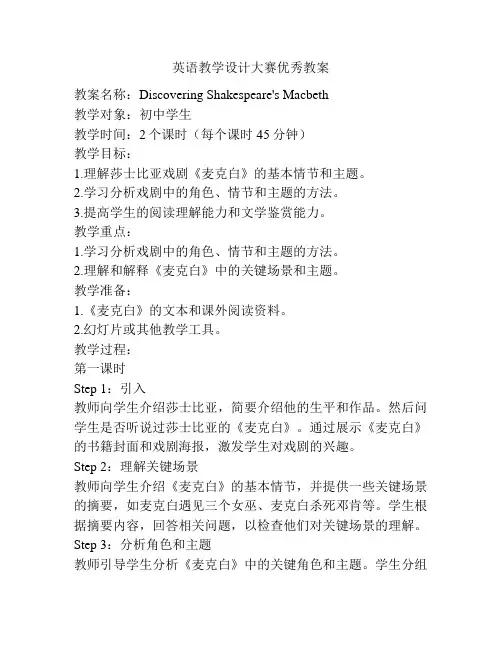
英语教学设计大赛优秀教案教案名称:Discovering Shakespeare's Macbeth教学对象:初中学生教学时间:2个课时(每个课时45分钟)教学目标:1.理解莎士比亚戏剧《麦克白》的基本情节和主题。
2.学习分析戏剧中的角色、情节和主题的方法。
3.提高学生的阅读理解能力和文学鉴赏能力。
教学重点:1.学习分析戏剧中的角色、情节和主题的方法。
2.理解和解释《麦克白》中的关键场景和主题。
教学准备:1.《麦克白》的文本和课外阅读资料。
2.幻灯片或其他教学工具。
教学过程:第一课时Step 1:引入教师向学生介绍莎士比亚,简要介绍他的生平和作品。
然后问学生是否听说过莎士比亚的《麦克白》。
通过展示《麦克白》的书籍封面和戏剧海报,激发学生对戏剧的兴趣。
Step 2:理解关键场景教师向学生介绍《麦克白》的基本情节,并提供一些关键场景的摘要,如麦克白遇见三个女巫、麦克白杀死邓肯等。
学生根据摘要内容,回答相关问题,以检查他们对关键场景的理解。
Step 3:分析角色和主题教师引导学生分析《麦克白》中的关键角色和主题。
学生分组讨论,然后汇报和展示他们的分析结果。
教师可以提供一些问题来引导学生的讨论,如“麦克白和他的妻子是如何逐渐堕落的?”、“野心是戏剧的主题之一,请举例说明。
”等。
Step 4:文学鉴赏教师向学生介绍文学鉴赏的概念,并教授一些基本的戏剧分析技巧,如分析角色的动机和行为、分析戏剧的主题和情节等。
然后,学生根据自己学到的分析技巧,阅读《麦克白》的节选并回答相关问题。
第二课时Step 5:讨论学生分享他们对《麦克白》节选的分析结果,并进行讨论。
教师引导学生深入探讨戏剧的主题和意义,并帮助他们加深对《麦克白》的理解。
Step 6:评价教师向学生介绍戏剧评价的概念,并要求学生根据自己的理解和喜好,评价《麦克白》的价值和意义。
学生可以将自己的评价写成短文或进行口头表达。
Step 7:总结教师与学生总结本节课的学习成果,并鼓励学生继续阅读和探索莎士比亚的其他作品。
全国英语教师教学设计大赛获奖作品—初中精品教案
全国英语教师教学设计大赛获奖作品—初中精品教案一、教学内容本节课教学内容选自《新目标英语》八年级上册第三章《A visit to the UN》。
具体内容包括第三单元Section A,着重讨论联合国及其在促进世界和平与发展中作用。
详细内容包括词汇学习、语法点(一般过去时)、会话练习以及相关阅读理解。
二、教学目标1. 让学生掌握与联合国相关词汇,如:assembly, resolution, peacekeeping等。
2. 培养学生运用一般过去时描述过去事件语法能力。
3. 提高学生听说能力,能够就联合国角色和活动进行简单对话。
4. 增强学生对国际组织及其在全球事务中作用理解。
三、教学难点与重点教学难点在于一般过去时正确运用及其与现在时区别,以及联合国相关词汇准确记忆。
教学重点在于通过对话和阅读练习,让学生在实际语境中灵活运用所学知识。
四、教具与学具准备1. 多媒体教学设备,用于播放对话录音和展示PPT。
2. 教学卡片,用于词汇学习和小组活动。
3. 学生笔记本,用于记录重要知识点和练习。
五、教学过程1. 导入新课:通过展示联合国图片,引发学生思考其在国际事务中作用,自然引入新课。
小组讨论:让学生探讨联合国标志意义。
录音播放:听一段关于联合国工作对话,让学生预测对话内容。
2. 新知呈现:词汇教学:通过PPT展示和教学卡片,讲解并让学生练习新词汇。
语法讲解:以对话为例,讲解一般过去时用法。
3. 例题讲解:展示例题,解释一般过去时构造和应用。
让学生模仿例题,进行句子构造练习。
4. 随堂练习:分组对话练习:学生模拟联合国会议,进行角色扮演。
个人阅读理解:完成关于联合国阅读理解练习。
5. 巩固拓展:对话复述:学生复述所听对话,巩固词汇和语法。
角色扮演:学生模拟联合国代表,讨论国际问题。
六、板书设计板书将包括:1. 新词汇及其翻译。
2. 一般过去时构造和示例句子。
3. 联合国主要职能和活动。
七、作业设计1. 作业题目:编写一段关于联合国某次重要活动报道,至少包含5个新学词汇和一般过去时正确使用。
英语阅读教学设计大赛优秀教案模板
英语阅读教学设计大赛优秀教案模板通过本课程的学习,学生将能够:1. 理解文章中的重要事实和细节。
2. 识别并理解文章中的主题和中心思想。
3. 使用有效的阅读策略来帮助理解文章。
4. 熟练掌握词汇和语法知识,以便更好地理解文章。
教学资源1. 一本阅读材料,约500字。
2. 词汇表和语法练习。
3. 阅读策略提示卡。
教学步骤第一步:导入1. 学生和老师互相问候,并确定本课的目标和目的。
2. 介绍本课的阅读材料。
3. 提醒学生使用阅读策略。
第二步:阅读材料1. 学生阅读材料。
2. 学生标记和记录文章中的关键信息和细节。
3. 学生使用阅读策略提示卡。
第三步:语法和词汇1. 学生完成语法和词汇练习。
2. 学生检查自己的答案。
第四步:理解中心思想1. 学生回答一些与中心思想相关的问题。
2. 学生讨论文章的主题和意义。
第五步:总结1. 学生汇报他们的发现和答案。
2. 学生和老师一起总结和回顾课程。
3. 学生和老师一起讨论下一步的行动和学习计划。
教学策略1. 使用阅读策略提示卡。
2. 帮助学生理解文章的结构和组织。
3. 使用多个学习资源,如词汇表和语法练习。
4. 鼓励学生使用自己的阅读策略和技巧。
评估方法1. 通过学生的回答问题和参与课堂讨论来评估他们的理解和参与度。
2. 通过语法和词汇练习来评估学生的掌握程度。
3. 通过学生的阅读记录和标记来评估他们的阅读策略使用情况。
改进策略1. 提供更多的语法和词汇练习以帮助学生更好地掌握语言知识。
2. 给学生更多的机会使用阅读策略,以帮助他们更好地理解文章。
3. 鼓励学生使用自己的阅读策略和技巧,以提高他们的阅读技能。
小学英语教学设计全英 小学英语教学设计一等奖汇总(5篇)
小学英语教学设计全英小学英语教学设计一等奖汇总(5篇)小学英语教学设计全英小学英语教学设计一等奖篇一一、英语unit 1《e with me》教学设计一、教学目标:1、认识目标: is this your dictionary? no,it's 'stony's does she do? she's a doctor.2、能力目标:listen and look3、情感目标:鼓励学生大胆开口说英语,用英语打招呼二、教学内容:listen and look三、教学重难点:重难点是句型的综合运用。
四、课前准备:录音机单词卡挂图五、教学过程:1、listen and sing.“what do you want to do?”2、ask and answer:--what's his name?(point to gogo)--his name's gogo.--can he fly?--yes,he can.--can he use magic?--yes,he can.3、让学生观看vcd,跟读,并把句子板书出来,学生认读。
--where are you going?--i'm going to an island.--we can't fly.--e withme./let's go.4、师生操练、生生操练句型。
5、呈现listen and look,要求学生把听到的句子说出来。
6、pair work and act.7、point and say.8、homework(1)把课文读给家长听。
(2)表演与同学的对话,用英语问候老师和同学。
六、板书设计: unit one e with me--where are you going?--i'm going to an island.--we can't fly.--e with me./let's go.七、教学反思:小部分学生比较难上口,需要反复读说。
教学设计大赛一等奖教案-人教新目标英语八上Unit1Section A(1a-2d)
Unit 1 Where did you go on vacation?Section A 1 (1a-2d)教学设计Learning Goals:一、语言知识(常用词汇和短语)anyone, anywhere, wonderful, quite a few, most, something, nothing, everyone, of course, myself, yourself二、语言技能1)能掌握以下句型:①—Where did you go on vacation? —I went to the mountains.②—Where did Tina to on vacation? —She went to the beach.③—Did you go with anyone? —Yes, I did./No, I didn’t.2) 能了解以下语法:—复合不定代词someone, anyone, something, anything等的用法。
—yourself, myself等反身代词的用法。
3)能掌握一般过去时态的特殊疑问句,一般疑问句及其肯定、否定回答。
并能用过去时谈论过去的事情。
三、学习策略1:能利用句子重音捕捉关键信息,把握所听内容的大意。
2:能通过词义的积极性或消极性判断,理解文章中人物的感受。
3:能利用话题思维导图对词语归类整理,提高词语识记效率。
四、情感态度:学会用一般过去时进行信息交流,培养学生的环保意识,热爱大自然。
五、文化意识了解国内外著名游览胜地,如:黄果树瀑布,中央公园等。
【设计意图】目标引领,表述了本节课的知识、能力、学习策略、情感态度和文化意识。
Teaching and learning stepsStep1. Preview(教师寄语: No pains, no gains.没有付出就没有收获。
)Read from P1 to P3 and put the Chinese into English orally, then write them down without looking at your book..P1: 翻译下列短语1: 去海滩________________ 2:去爬山_______________3:待在家里____________ 4:拜访/看望…老师________5:去度假_______________ 6:参观博物馆_____________7:去参加夏令营___________P2:翻译下列句子1.好久不见。
- 1、下载文档前请自行甄别文档内容的完整性,平台不提供额外的编辑、内容补充、找答案等附加服务。
- 2、"仅部分预览"的文档,不可在线预览部分如存在完整性等问题,可反馈申请退款(可完整预览的文档不适用该条件!)。
- 3、如文档侵犯您的权益,请联系客服反馈,我们会尽快为您处理(人工客服工作时间:9:00-18:30)。
附件:参赛教学设计模板
的理解、掌握和运用没有问题。
同样,对情态动词“could ,should ”等的理解、掌握和运用也没有问题。
(2)学生的听力和对话能力较强,所以,结对训练或小组训练应该会很顺利。
3. 教学目标分析
⑴知识与技能
①能拼读和掌握本单元新词汇。
②会就谈论的问题给出合理的建议。
③会应用句型“ Why don' t you? What should I do?”和情态动词
“ could ,should ”等。
⑵过程与方法
①通过听对话和读短文,会应用情态动词“could ,should ”等。
②通过结对活动和小组活动,学会谈论问题。
⑶情感、态度与价值观
①学会冷静聪明地处理和解决问题。
②以帮助有困难的人为乐。
4. 教学重点、难点分析
教学重点:
⑴掌握新词汇。
⑵句型“ Why don' t you? What should I do? ”的理解、掌握和运用。
教学难点:
⑴情态动词“ could ,should ”等的理解、掌握和运用。
步骤5:巩固。
